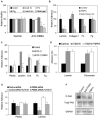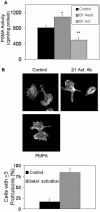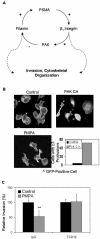Prostate-specific membrane antigen regulates angiogenesis by modulating integrin signal transduction
- PMID: 16809768
- PMCID: PMC1592718
- DOI: 10.1128/MCB.00084-06
Prostate-specific membrane antigen regulates angiogenesis by modulating integrin signal transduction
Abstract
The transmembrane peptidase prostate-specific membrane antigen (PSMA) is universally upregulated in the vasculature of solid tumors, but its functional role in tumor angiogenesis has not been investigated. Here we show that angiogenesis is severely impaired in PSMA-null animals and that this angiogenic defect occurs at the level of endothelial cell invasion through the extracellular matrix barrier. Because proteolytic degradation of the extracellular matrix is a critical component of endothelial invasion in angiogenesis, it is logical to assume that PSMA participates in matrix degradation. However, we demonstrate a novel and more complex role for PSMA in angiogenesis, where it is a principal component of a regulatory loop that is tightly modulating laminin-specific integrin signaling and GTPase-dependent, p21-activated kinase 1 (PAK-1) activity. We show that PSMA inhibition, knockdown, or deficiency decreases endothelial cell invasion in vitro via integrin and PAK, thus abrogating angiogenesis. Interestingly, the neutralization of beta(1) or the inactivation of PAK increases PSMA activity, suggesting that they negatively regulate PSMA. This negative regulation is mediated by the cytoskeleton as the disruption of interactions between the PSMA cytoplasmic tail and the anchor protein filamin A decreases PSMA activity, integrin function, and PAK activation. Finally, the inhibition of PAK activation enhances the PSMA/filamin A interaction and, thus, boosts PSMA activity. These data imply that PSMA participates in an autoregulatory loop, wherein active PSMA facilitates integrin signaling and PAK activation, leading to both productive invasion and downregulation of integrin beta(1) signaling via reduced PSMA activity. Therefore, we have identified a novel role for PSMA as a true molecular interface, integrating both extracellular and intracellular signals during angiogenesis.
Figures








Similar articles
-
Prostate-specific membrane antigen (PSMA)-mediated laminin proteolysis generates a pro-angiogenic peptide.Angiogenesis. 2016 Oct;19(4):487-500. doi: 10.1007/s10456-016-9521-x. Epub 2016 Jul 8. Angiogenesis. 2016. PMID: 27387982
-
Prostate specific membrane antigen produces pro-angiogenic laminin peptides downstream of matrix metalloprotease-2.Angiogenesis. 2013 Oct;16(4):847-60. doi: 10.1007/s10456-013-9360-y. Epub 2013 Jun 18. Angiogenesis. 2013. PMID: 23775497
-
Tumor target prostate specific membrane antigen (PSMA) and its regulation in prostate cancer.J Cell Biochem. 2004 Feb 15;91(3):528-39. doi: 10.1002/jcb.10661. J Cell Biochem. 2004. PMID: 14755683 Review.
-
Prostate-specific membrane antigen association with filamin A modulates its internalization and NAALADase activity.Cancer Res. 2003 May 15;63(10):2645-8. Cancer Res. 2003. PMID: 12750292
-
Is prostate-specific membrane antigen a multifunctional protein?Am J Physiol Cell Physiol. 2005 May;288(5):C975-81. doi: 10.1152/ajpcell.00506.2004. Am J Physiol Cell Physiol. 2005. PMID: 15840561 Review.
Cited by
-
First communication on the efficacy of combined 177Lutetium-PSMA with immunotherapy outside prostate cancer.J Immunother Cancer. 2022 Oct;10(10):e005383. doi: 10.1136/jitc-2022-005383. J Immunother Cancer. 2022. PMID: 36288828 Free PMC article.
-
Single-cell analysis of multiple cancer types reveals differences in endothelial cells between tumors and normal tissues.Comput Struct Biotechnol J. 2022 Dec 30;21:665-676. doi: 10.1016/j.csbj.2022.12.049. eCollection 2023. Comput Struct Biotechnol J. 2022. PMID: 36659929 Free PMC article.
-
Imaging and Characterization of Macrophage Distribution in Mouse Models of Human Prostate Cancer.Mol Imaging Biol. 2019 Dec;21(6):1054-1063. doi: 10.1007/s11307-019-01318-5. Mol Imaging Biol. 2019. PMID: 30805886
-
A method to determine the mode of binding for GCPII inhibitors using bio-layer interferometry.J Enzyme Inhib Med Chem. 2016 Dec;31(6):1690-3. doi: 10.3109/14756366.2015.1132208. Epub 2016 Feb 12. J Enzyme Inhib Med Chem. 2016. PMID: 26873576 Free PMC article.
-
[The role of PSMA PET-CT in patients with metastatic prostate cancer].Urologe A. 2017 Nov;56(11):1410-1416. doi: 10.1007/s00120-017-0513-2. Urologe A. 2017. PMID: 28980045 Review. German.
References
-
- Anilkumar, G., S. A. Rajasekaran, S. Wang, O. Hankinson, N. H. Bander, and A. K. Rajasekaran. 2003. Prostate-specific membrane antigen association with filamin A modulates its internalization and NAALADase activity. Cancer Res. 63:2645-2648. - PubMed
-
- Arroyo, A. G., A. Garcia-Pardo, and F. Sanchez-Madrid. 1993. A high affinity conformational state on VLA integrin heterodimers induced by an anti-β1 chain monoclonal antibody. J. Biol. Chem. 268:9863-9868. - PubMed
-
- Bacich, D. J., E. Ramadan, D. S. O'Keefe, N. Bukhari, I. Wegorzewska, O. Ojeifo, R. Olszewski, C. C. Wrenn, T. Bzdega, B. Wroblewska, W. D. Heston, and J. H. Neale. 2002. Deletion of the glutamate carboxypeptidase II gene in mice reveals a second enzyme activity that hydrolyzes N-acetylaspartylglutamate. J. Neurochem. 83:20-29. - PubMed
-
- Barker, J. N. 1991. The pathophysiology of psoriasis. Lancet 338:227-230. - PubMed
-
- Bauvois, B. 2004. Transmembrane proteases in cell growth and invasion: new contributors to angiogenesis? Oncogene 23:317-329. - PubMed
Publication types
MeSH terms
Substances
Grants and funding
LinkOut - more resources
Full Text Sources
Other Literature Sources
Molecular Biology Databases
Research Materials
Miscellaneous
